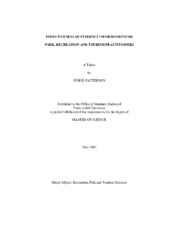| dc.description.abstract | This research is a four-step process. 1) Development of the Park, Recreation and Tourism (PRT) Planning Web site to meet the needs of rural communities, indicated through the Texas Community Futures Forum needs assessment process. 2) Evaluation of the PRT Planning Web site by experts in the field of PRT Sciences. 3) Inspect differences in the information needs and use between rural and urban PRT practitioners. 4) Examine factors contributing to the flow experience while utilizing the PRT Planning Web site.
Evaluation information provided insight about strengths, weakness and modifications to be made to the PRT Planning site. Programming was reported as the service provided most by survey participants. Internet information is considered the most effective information resource, with suppliers/manufacturers and libraries being the least effective. When acquiring information on developing and providing PRT services, not knowing where to find information was the problem experienced most, while not understanding the information was the problem encountered the least. Marketing information was deemed the most useful type of information, and increasing community well being is the most important service benefit provided by respondents.
No significant differences were reported between groups' perception of Internet information as the most effective information resource, intent to return to the PRT Planning Web site, or education levels. Significant differences were reported between groups' Internet connection speed, use of a dial-up modem, computer experience and Internet experience. Study findings also reported less computer and Internet experience for rural and small communities when compared to large and urban communities.
In Skadberg's (2002) proposed model of flow in human-computer interaction, the factors that contribute to the flow experience are, experience, ease of use, response speed, interactivity, vividness, telepresence, knowledge of the information being presented, and challenge of the information being presented. Of these factors, experience was the only variable that did not show a significant or positive relationship with factors in the flow model. Increased learning and change in attitude and behavior are considered outcomes of achieving the flow state; both reflected a positive and significant relationship with the variable flow. | en |


